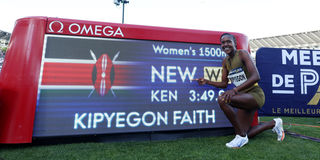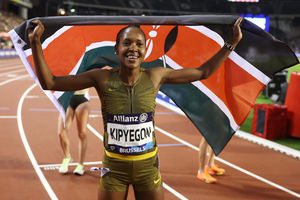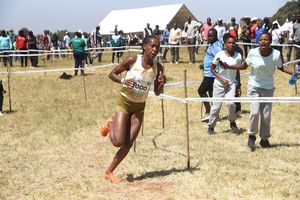
Faith Kipyegon reacts after winning Olympics 1500m gold on August 10, 2024.
Olympics 1,500 metres champion, Faith Kipyegon, must strike a consistent pace of 59.75 seconds in each 400m lap of the Mile (1,600m) if she is to succeed in running the mile in less than four minutes in Nike “Breaking4” project on Thursday in Paris.
Kipyegon, 31, will run the highly choreographed race on Thursday at Charléty Stadium in Paris, where she broke her own 1,500m world record last year. The race will be held at 9 pm (Kenyan time). The triple Olympic and world 1,500m champion will attempt to be the first woman to run the sub-four-minute mile in a Nike “Breaking 4” project following the success of Eliud Kipchoge’s sub-two-hour marathon.
Kipyegon, who holds the one-mile world record of 4 minutes and 07.64 seconds from the Monaco Diamond League on July 21, 2023, has a massive task of shaving off 7.65 seconds from her previous world record when she attempts the feat.
It means that for Kipyegon to run the mile under four minutes, she has to run the race in 239 seconds so as to return a time of 3:59.00 at the end of the race.

Faith Kipyegon reacts after winning Olympics 1500m gold on August 10, 2024.
Kipyegon will need to run each of the four laps in the race an average of nearly two seconds faster. This is a significant accomplishment, considering it took many progressive efforts stretching over 34 years to trim eight seconds off Paula Ivan’s record in 1989 when women’s mile times were first tracked, to Kipyegon’s current record.
The Nike-sponsored “Breaking4” project will cover four laps for a total distance of 1,609m, and is markedly different from the 1,500m race commonly known as “the metric mile” race.
As with Kipchoge’s 1:59:40.2 marathon in Vienna in 2019, Kipyegon will be aided by “in and out” pacers, new high-tech shoes and kit and other technological, physiological and psychological help that will mean any record will not be officially recognised.
Kipyegon also holds the 1,500m world record of 3:49.04 from the Paris Diamond League on July 7, 2024.
The gates at Charléty Stadium will open at 6:30 pm (Kenyan time) on Thursday, with the programme of the day beginning at 8 pm. Kipyegon’s attempt is planned for 9 pm.
Kipyegon, who holds three Olympic and world 1,500m titles, reckons that nothing much has changed in her diet and training.

Faith Kipyegon after setting a new world record in the women's 1500m at Paris Diamond League on July 7, 2024.
Inspired by Briton Roger Barrister, who made history in 1954 as the first mine to run a mile on track in under four minutes, Kipyegon wants to achieve the accolades in the women’s mile. Barrister famously ran the mile in three minutes and 59.4 seconds on May 6, 1954, breaking the perceived barrier of human limit.
The 31-year-old who also holds the 1,500m world record and previously held the 5,000m world record, said she hasn’t changed her diet, nor the distances she covers during her training.
However, Kipyegon said that the thinking around the race, including the time the race will take place, training regime, and the kit that she will use feels quite different from when she was preparing for the Olympics, world and Diamond League races.
“My breakfast is still the same with bread, brewed fresh milk tea and eggs, either fried or boiled,” Kipyegon, who prefers rice accompanied with beans for lunch, said.
Inspires next generation of athletes
“My dinner has lots of proteins like beef and kienyeji (local) chicken consumed with Ugali and washed down with mursik or the normal fermented milk,” she explained. Mursik is Kalenjin sour milk that is infused with special charcoal.
“I have been doing between 130km and 150km or even 180km per week, just like when I am training for 1,500m races, so no major changes.
“That distance covers track and the terrains in the forest,” said Kipyegon, adding that the running body suit and spikes that Nike has developed for the project feel quite different. “The thinking around the race is quite different.”
Kipyegon said that after winning the world, Olympics, Commonwealth Games and Diamond League titles, she is keen to come out with something different that would give women hope and empower them.

Faith Kipyegon celebrates after winning the women's 1500m race to set a new world record during the Athletics Diamond League in Paris on July 7, 2024.
“I wanted something that pushes beyond the boundaries and inspires the next generation of athletes and thinkers in every facet of life,” explained Kipyegon.
“I want to tell them that their dreams are valid and it can only work when we try and think outside the box.”
“I am so excited and eager to know what the finish line will offer,” said Kipyegon, adding that the race is beyond winning medals at championship races.
Kipyegon said that the running shoes and body suit she will use feel much different from the ones she has been using.
“They feel light and comfortable with experts having spent time to come up with them,” said Kipyegon.
Kipyegon has been training under coach Patrick Sang in Kaptagat in Iten, Uasin Gishu County, with Global Sports Communication camp that also has two-time Olympic marathon champion Kipchoge, and 2012 world indoor 3,000m silver medallist Augustine Choge
A massive team of Nike innovators, scientists, designers and dreamers have worked behind the scenes, burning the midnight oil to make the impossible possible for ‘Breaking4’ project. Rather than a standard ‘Nike Victory 2’ spikes, Nike have delivered a signature spike for Kipygeon called ‘Nike Victory Elite FK’ (as in “Faith Kipyegon” or “Fastest Known”), dubbed “Dev 611” by World Athletics and approved in its database list of shoes for ratified competitions.
They weigh approximately 85 grams (about three ounces).
Last year in Paris, Nike designers were already evaluating Kipyegon’s go-to spikes for her future mile attempt.
The tailor-made spikes are taller Zoom Air units so as to extend efficiency deeper into the race when margins matter. They are tailored to Kipyegon’s stride and the demands of holding a roughly 15-mile-per-hour running pace.
“Faith’s spike features completely new components designed to increase her energy return and improve her running efficiency,” Carrie Dimoff, footwear product director at Nike Innovation, told GearJunkie website.
“The spike is also significantly lighter than anything she’s worn before. If she crosses the line in under four minutes, it won’t just be a new world record. It’ll be a new understanding of what’s possible for women in sport,” explained Dimoff.

Faith Kipyegon tests an early prototype of the Nike Fly Suit at her training camp in Kenya.
Kipyegon’s “Fly Suit“ is the most aerodynamic speed suit in running history, resembling a professional cycling suit that is subject to wind-tunnel testing.
Kipyegon’s Nike “Fly Suit” for running has undergone similar scrutiny, with Nike noting that the one-piece suit is its most aerodynamic apparel solution ever engineered using both computer simulations and physical wind-tunnel testing.
The Fly Suit is built with a complementary headband and arm and leg sleeves, and with a new Nike invention called “Aeronodes” - spherical half-circles - strategically placed to split the air in front of Kipyegon and create smaller eddies behind her to reduce drag.
Kipyegon will also wear a new, one-of-one bra made of Nike FlyWeb, a 3D-printed TPU material optimised for moisture management, better than any typical textile. The bra’s racerback style provides more range of motion, and the computationally designed form features a dynamic, precision-tuned surface that’s denser in some places for higher support.
“Sports bras have never looked or felt like this before,” Nike Apparel Innovation Vice President Janett Nichol said during the launch of the kit. “The material is soft, light and incredibly supportive-yet it also feels like you’re not wearing anything at all.”








